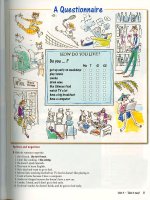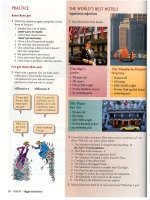Unit 2 new headway elementary
Bạn đang xem bản rút gọn của tài liệu. Xem và tải ngay bản đầy đủ của tài liệu tại đây (133.38 KB, 8 trang )
<span class='text_page_counter'>(1)</span><div class='page_container' data-page=1>
<b>UNIT 2. MEETING PEOPLE</b>
<b>Level: Elementary</b>
<b>Time allowance: 45 minutes</b>
<b>Class size: </b>
<b>Aims: </b>
<i>- Provide emphasis on questions and negatives with the verb “to be”and the short </i>
<i>answers. </i>
<i>- Introduce the use of possessive </i>
<i><b>’s </b></i>
<i>form</i>
<i>- vocabulary about members of the family (father, aunt, etc.), other words for</i>
<i>personal relationships (boyfriend/girlfriend,…) plus common adjectives and their</i>
<i>opposites are also mentioned</i>
<b>Objectives</b>: By the end of the lesson, students will be able to
- <i>Better at using the questions and negatives with the verb to be and the short answers.</i>
- <i>Know how to use possessive ’s </i>
- <i>Equip themselves new words about members of family, words for personal relationships </i>
<i>and common adjectives and their opposites.</i>
- <i>Know how to make conversations in a cafe.</i>
<b>Anticipated problems</b>:
<i>Students may have difficulty in saying prices in English. There are some ways to say prices; </i>
<i>therefore teacher should teach the easiest way so that students don’t find it confused.</i>
<b>Procedure</b>
PERIOD 1
<b>Content</b> <b>Time</b> <b>Teacher’s activities</b> <b>Students’ activities</b>
STARTER 5
mins - Get students to count from
1-20
around the class. Repeat so that
everyone has a chance to practice or if
students make mistakes
- Ask students to count in tens from
10-100around the class. Check for
correct stress, and repeat until students
can say the numbers quickly and
accurately.
- Tell students my own age and then
briefly revise numbers that reflect the
age of the students. Drill the question
<i>How old are you? Then ask students to</i>
work in groups of three or four and ask
and answer about ages. Ask for a few
examples of ages to practice
- Count from 1-20 around the class.
- Count from 10-100 as a class first
and then work individually in turn.
- Work in groups of 3 or 4 to ask
and answer about ages.
<i>A: How old are you</i>
<i>B: I’m eighteen.</i>
WHO IS SHE?
<i>Questions and </i>
<i>negatives</i>
10
mins
<i><b>Present the form of WH- questions </b></i>
<i><b>and YES/NO questions</b></i>
- write some examples on the board
and the ask students to form the WH-
question and YES/NO question with
the verb to be
</div>
<span class='text_page_counter'>(2)</span><div class='page_container' data-page=2>
WH- questions
<i>What is your name? – My name’s </i>
<i>John</i>
<i>What is his job? – I’m a student</i>
<i>What is her surname?</i>
<b>What + to be + N</b>
<i>Where is she from? – She’s from VN</i>
<i>Where are you from? – I’m from …</i>
<i>Where are they from?</i>
<b>Where + to be + S + from?</b>
<i>Who is Peter? - He’s my brother</i>
<i>Who are they? - they are my friend</i>
<b>Who + to be + S?</b>
<i>How old is she? - she’s nineteen</i>
<i>How old are you? - I’m seventeen</i>
<b>How old + to be + S?</b>
<i>How much is a pen? – It’s $10</i>
<i>How much is an ice-cream? </i>
<b>How much + to be + N?</b>
<i><b>YES/NO question</b></i><i>Am I handsome?</i>
<i>Are you married?</i>
<i>Is she young?</i>
<b>Am/is/are + S + adj?</b>
<i>Are they your friend?</i>
<i>Is she a teachers?</i>
<b>Am/is/are + S + N?</b>
<i>- Yes, S +am/is/are</i>
<i>- No, S + am not/is not/ are not</i>
3
mins
<b>Activity 1:</b>
Ask students to read about Lisa
Jefferson. Check comprehension of the
key vocabulary: surname, first
<i>name, address, and journalist.</i>
- work in pairs and read the
information about Lisa Jefferson
7
mins
<b>Activity 2</b>
- Ask students to complete the
questions
- ask students to listen to the recording
and check the answers.
- Ask students to practice the questions
and answers. Introduce the intonation
in questions in English to students
before they have practice.
<i>+ Questions with a question word </i>
- work in pairs and complete the
questions.
- listen and check the answers
individually.
</div>
<span class='text_page_counter'>(3)</span><div class='page_container' data-page=3>
<i>start high and fall.</i>
<i>+ Yes/no questions usually rise at the </i>
<i>end.</i>
5
mins
<b>Activity 3</b>
- Ask students to write questions about
Lise’s brother, basing their questions on
task 2
- Play the recording and ask students to
listen and complete the information.
- work in pairs and write questions
about Lise’s brother.
- Listen and complete the
information individually.
<i>Negative and </i>
<i>short answers.</i>
5
mins
<b>Activity 4</b>
- Ask students to read and listen to the
Yes/no questions and short answers.
Play the recording.
- Play the recording again and ask
students to repeat, emphasizing the
rising intonation on the question and
the pronunciation of the contracted
form isn’t.
- Ask students to ask and answer
<i>yes/no questions about Lisa. Go </i>
around the class and provide help if
necessary
- Read and listen to the questions
and answers individually.
- Listen and repeat as a class.
- work in pairs to ask and answer
<i>yes/no question about Lisa</i>
5
mins
<b>Activity 5 </b>
- Ask students to ask and answer
questions about Lisa’s brother.
Go around the class and provide help if
necessary.
- Work in pairs and ask and answer
yes/no questions about Lisa’s
brother
<i>A: Is his name’s Peter?</i>
<i>B: No, it isn’t. He’s Jefferson</i>
<i>A: Is he a journalist?</i>
<i>B: Yes, he is.</i>
<i>…</i>
<i>Grammar spot</i> 5
mins
- Ask students to complete the answers
to the Yes/no questions.
- Check the answers
- Focus attention on the negative forms
and point out especially that we cannot
say <b>“I amn’t.”</b>
<b>- </b>Ask students to read grammar
reference 2.1 on p125 together in class
Explain sometime if necessary.
</div>
<span class='text_page_counter'>(4)</span><div class='page_container' data-page=4>
PERIOD 2
PRACTICE
<i>Who is he?</i>
<i>Talking about </i>
<i>you</i>
5
mins
<b>Practice 1:</b>
- Allocate the pairs, and give the
photocopied card to Student B.
- Ask student A to look at the
information in exer. 1 and student B
look at the card. Then ask them to ask
and answer questions to complete the
information in the cards.
- Work in pairs to ask and answer
questions to complete the
information.
5
mins
<b>Practice 2</b>
- Ask student to ask and answer about
Patrick
- Demonstrate the activity by asking
this first question about Patrick's
surname and getting students to
answer. Monitor and check for correct
formation of questions and short
answers.
- Work in pairs to ask and answer
about Patrick.
10
mins
<b>Practice 3</b>
- Demonstrate the activity by asking
students the example questions in the
Student's Book.
- Get students to ask you the questions
for each category on the identity card.
<i>surname, first name, country, job, </i>
<i>address, phone number, age, marital </i>
<i>status.</i>
- Correct mistakes carefully.
- Listen and take note sometime
- Ask and answer questions with a
partner
<i>A: What’s your first name?</i>
<i>B: Nguyen</i>
<i>A: Are you married?</i>
<i>B: No, I’m not.</i>
<i>A: what’s your job?</i>
<i>B: I’m a student</i>
<i>A: How old are you?</i>
<i>B: I’m eighteen.</i>
<i>…</i>
5
mins
<b>Practice 4</b>
- Give each student a photocopied
form in exer. 4
- Ask students to go around the class
and ask two other students questions to
complete the form
- Call some students to tell the class
one of the students they just ask for
information.
- Check for pronunciation if necessary.
- Go around the class and ask two
other students questions to
complete the form given.
- Tell the class about one of the
students in the form.
<i>PATRICK’S </i>
<i>FAMILY</i>
<i>Presentation of</i>
<i>Possessive ’s </i>
5
mins
<b>Activity 1</b>
- Focus attention on the vocabulary
table and on the example
- Ask students complete the table.
Monitor and check for correct
pronunciation
- Check the answers. Drill some of the
words to practice the pronunciation.
- work in pairs and write the words
in the correct place. Use dictionary
to help.
</div>
<span class='text_page_counter'>(5)</span><div class='page_container' data-page=5>
5
mins
<b>Activity 2</b>
- Focus attention on the photograph.
Ask students to read and listen and put
the names next to the right person.
- Check the answers by pointing to
each person and asking students for the
correct name.
- Focus attention on the use of 'sas the
contraction of is and as an indicator of
possession
- Refer students back to the text about
Patrick. Get them to work in pairs and
underline the use of possessive 's and
circle the use of 'sas the contraction of
<i>is.</i>
- Check the answers.
- Read and listen individually and
then put the names next to the right
person.
- Check the answers.
- Listen and take note
- Work in pairs and underline the
use of possessive ’s and circle the
use of ’s as the contraction of is
5
mins
<b>Activity 3</b>
- Ask students to ask and answer
questions about Patrick’s family.
- Go around the class and provide help
if necessary.
- Work in pairs asking and
answering about Patrick’s family.
<i>S1: Who’s Brenda?</i>
<i>S2: She’s Patrick’s wife?</i>
<i>S1: Who’s Lara?</i>
<i>S2: she’s Patrick’s daughter.</i>
<i>S1: Who’s Benny?</i>
<i>S2: He’s Patrick’s son</i>
<i>…</i>
PERIOD 3
PRACTICE
<i>You and your </i>
<i>family</i>
5
mins
<b>Practice 1</b>
- Tell students to ask teacher questions
about the people in the family.
Direct students to ask questions about
<i>surname, first name, country, job, </i>
<i>address, phone number, age, marital </i>
<i>status.</i>
- In turn, ask teacher questions
about the people in his family.
10
mins
<b>Practice 2</b>
- Ask students to write down the
names of some of the people of their
family on a piece of paper. Then they
exchange pieces of paper with a
partner and ask and answer questions
about each other’s families.
- Go around the class and provide help
if necessary.
- write down the names of people
in their family
- exchange piece of paper with a
partner
- Ask and answer questions about
the partner’s family.
<i>A: Who’s Peter?</i>
<i>B: He’s my brother</i>
<i>A: Who’s Mary?</i>
<i>B: She’s my aunt. She’s my </i>
<i>mother’s sister.</i>
</div>
<span class='text_page_counter'>(6)</span><div class='page_container' data-page=6>
<i>Check it</i>
5
mins
<b>Practice 3</b>
- Ask students to make true sentences
with the verb to be
<i>- Check students’ answers and ask </i>
some students to read aloud the
sentences
- work individually and make true
sentences with the verb to be
- Read aloud the sentences.
5
mins
<b>Practice 4</b>
- Ask students to identify the correct
sentence
- Check the answers.
- Work in groups of 4 and identify
the correct sentences by ticking in
the small square.
VOCABULARY
<i>Opposites</i>
10
mins
<b>Activity 1</b>
<b>- </b>Ask students to match the adjectives
with their opposites
- Check the answers.
- Ask students to listen and repeat.
- Work in groups of 4 and match
the adjectives with their opposites.
Use dictionary if necessary.
- listen and repeat as a class.
10
mins
<b>Activity 2</b>
- Ask student to write about the
pictures, using the adjectives in
activity 1
- Listen and check the answers.
<b>- </b>Ask students to 6ractice saying the
sentences.
- Check students’ pronunciation if
necessary.
- Work in pairs and write about the
pictures.
- Listen and check the answers.
- Practise saying the sentences in
pairs.
PERIOD 4
READING
AND
LISTENING
<i>An email from </i>
<i>England</i>
5
mins
<b>Activity 1</b>
<b>- </b>Ask students to read first and then
listen to the email.
- Explain some new words and write
them on the board. Get students to
practice pronouncing in chorus.
- Provide some help if necessary.
- Read and listen to the email of
Danka sending to Jacek, her
brother in Poland.
- Practise pronouncing new words
and write them in the notebooks.
5
mins
<b>Activity 2</b>
- Ask students to match photographs
1-3 with a part of the email.
<b>- </b>Check the answers
- Work in groups of 4 and match
photographs with a part of the
email.
5
mins
<b>Activity 3</b>
- Ask students to correct the false
sentences about the email.
- Correct the false sentences as a
class.
10
mins
<b>Activity 4 </b>
- Ask students to write questions about
Danka’s email.
- Go around the class and provide help
if necessary.
- Check the answers.
- Ask students to ask questions and
answers about Danka’s email
- Work in pairs and write questions
about Danka’s email.
</div>
<span class='text_page_counter'>(7)</span><div class='page_container' data-page=7>
5
mins
<b>Activity 5</b>
- Play the recording of three
conversations
- Ask students to listen and guess
where Danka is and who she is with
- Check the answers by playing the
recording again.
- Listen to three conversations and
guess where Danka is and who she
is with.
- Check the answers.
WRITING 15
mins
- Ask student to write an email about
their class
- Pick some writings to read aloud in
front of the class.
- Write an email about the class.
Danka’s email may be a good
sample.
PERIOD 5
EVERYDAY
ENGLISH
<i>In a cafe</i>
10
mins
<b>Activity 1</b>
- Ask students to listen and read aloud
the prices. Check pronunciation.
- play the recording and ask students to
write the prices they hear.
- Give help if necessary
- Check the answer and get students to
repeat the prices in chorus.
- listen and read aloud the prices in
the table
- Write the prices they hear and
then practice saying them.
- Check the answers and practice
saying the prices.
10
mins
<b>Activity 2</b>
- Ask students to read the menu and
then match the food with the pictures.
- Ask student to drill the pronunciation
of the food and drink
- Read the menu and then match
the food with the pictures.
- Practise the menu items in pairs
by pointing to the pictures and
saying the names.
10
mins
<b>Activity 3</b>
- Ask students to listen and repeat the
names of the food.
- Give presentation on how to ask for
the price of something.
<i>How much is ……….?</i>
- Go around the class and provide help
if necessary.
- Correct the pronunciation carefully
- Listen and repeat chorally.
- Work in pairs ask and answer
questions about the price of the
food.
<i>A: How much is a tuna and egg </i>
<i>salad?</i>
<i>B: Five pounds twenty-five</i>
5
mins
<b>Activity 4</b>
<b>- </b>Ask students to listen to the
conversations and then fill in the
missing words.
- Play the recording again
- Work individually and do the
filling exercise.
- Check the answers
10
mins
<b>Activity 5</b>
<b>- </b>Ask students to practice the
conversations
- Go around the class and check
pronunciation
- Ask students to make similar
conversations.
- Practise the conversation in pairs.
</div>
<span class='text_page_counter'>(8)</span><div class='page_container' data-page=8></div>
<!--links-->









